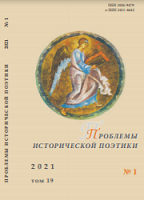Каменноостровский цикл А. С. Пушкина как пасхальный текст: мимесис, парафрасис, катарсис (Статья первая)
Kamennoostrovsky Cycle of Alexander Pushkin as Easter Text: Mimesis, Paraphrasis, Catharsis. Article 1
Author(s): Ivan EsaulovSubject(s): Christian Theology and Religion, Studies of Literature, Russian Literature, 19th Century
Published by: Петрозаводский государственный университет
Keywords: Pushkin’s lyrics; poetics; cyclization; Kamennoostrovsky Cycle; Easter nature; mimesis; paraphrasis; catharsis; Christian tradition;
Summary/Abstract: The article examines the artistic logic of the development of the Kamennoostrovsky Cycle by Alexander Pushkin, arguing for the presence of an Easter narrative in it. The fact that the author did not complete his last cycle, and the difficulty in determining the composition of the cycle leads to a variety of interpretations. Nonetheless, the work proves the need to limit arbitrary interpretations to the indication of the numbering of poems within the cycle, which was provided by the author himself. It is methodologically correct for a researcher to proceed from the following sequence of texts recognized by all Pushkin scholars: II. “Desert fathers and women are blameless” - III. “(Imitation of Italian)” - IV. “Worldly Power”. Since the prayer of Ephraim the Syrian is paraphrased in text II, referring the reader to Great Lent and Holy Week, in text III Pushkin refers to the betrayal of Judas, in text IV - to the crucifixion of Christ, the surviving author’s “backbone” of the cycle is strictly correlated with the middle of Holy Week. The artistic logic of the cycle is substantiated, leading to the correct reading of the superscript over the poem “(From Pindemonti)”, namely, No. I. The missing (not numbered by Pushkin) links of the author’s poetic construction are reconstructed: “In vain I run to the Zion heights”, “When outside the city, thoughtful, I wander” and “I erected a monument to myself not made by hands”. Using the categories of mimesis, paraphrasis and catharsis, presented here as a single system of concepts in their interconnection, the poetics of both Pushkin’s individual poems and the unity of the cycle are described. The first article offers a new understanding of the first five poems of the Kamennoostrovsky Cycle. The second part of the work is devoted to Pushkin’s “Monument”.
Journal: Проблемы исторической поэтики
- Issue Year: 19/2021
- Issue No: 1
- Page Range: 88-123
- Page Count: 36
- Language: Russian

